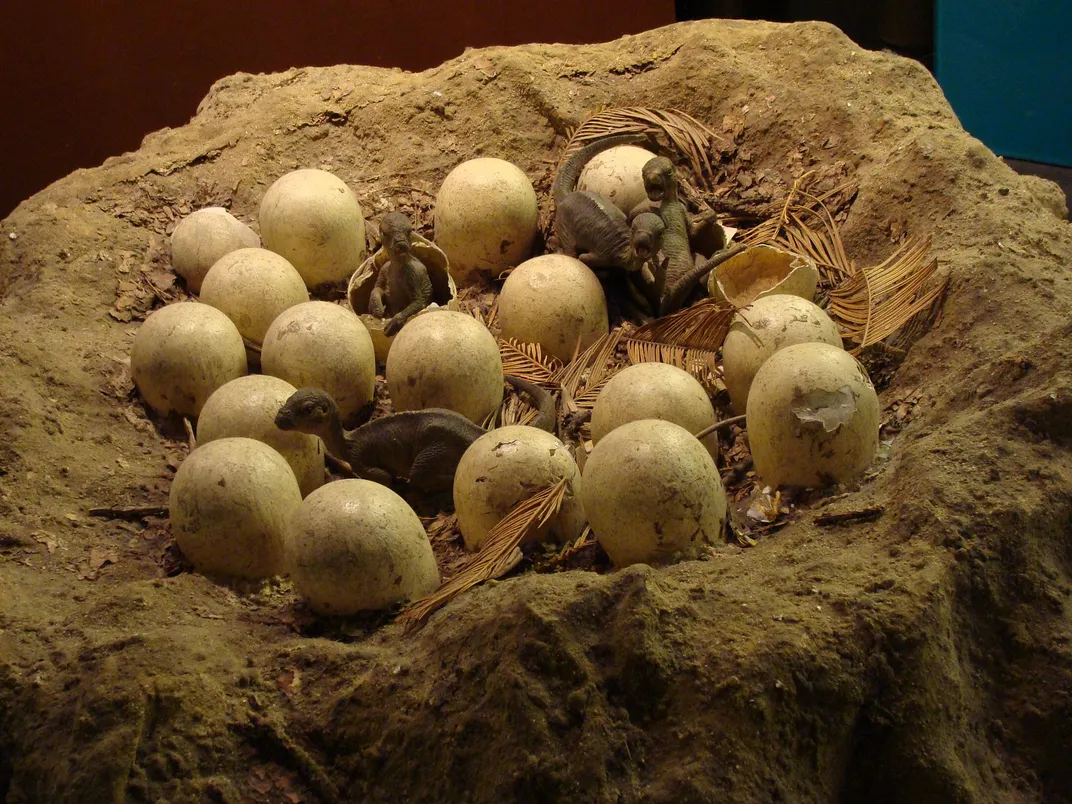Dinosaurs Literally Reshaped The Planet
Dinos didn’t just leave behind footprints and fossil bones—they also changed the landscapes in which they lived
/https://tf-cmsv2-smithsonianmag-media.s3.amazonaws.com/filer/cf/50/cf50aad6-1e05-47bd-afd4-725864ba5865/journalpone0036208g013.png)
For over 130 million years, dinosaurs dominated life on land. They came in every shape and size, from feathery little carnivores the size of a pigeon to titans that stretched over 120 feet in length. But dinosaurs did far more than merely inhabit prehistoric floodplains, deserts and forests. Unbeknownst to them, dinosaurs permanently altered the face of our planet.
One of the best places to see the echoes of dinosaurs is in the Broome Sandstone of western Australia. Back in the Early Cretaceous, between 135 and 130 million years ago, this part of the continent’s northern coast was covered in streams, swamps and lagoons. Large sauropod dinosaurs—think distant cousins of Apatosaurus—had to take care navigating between these mucky habitats, and as they did so they unknowingly changed the landscape around them.
The evidence is in the tracks. The Broome Sandstone, paleontologist Tony Thulborn pointed out in 2012, is dotted with foot-shaped potholes made by the trundling dinosaurs. In fact, the weight of these giants was so great that they deformed the sediment right beneath their feet to create what paleontologists call undertracks—think of them like ripples from each footfall pressed into stone. Many of these tracks and traces appear to cluster together, a sign of big dinosaurs following the same route around the edges of the lagoons, and in these places the dinosaurs made channels through the sand as they moved along the beach towards places where they might find more food. In a matter of weeks to months, flat shorelines were turned into stomping grounds cut through with dinosaur-made troughs.
The idea that dinosaurs were ancient landscapers shouldn’t come as a surprise. Large animals alive today, such as elephants and giraffes, can change entire environments merely by walking and eating. Given that elephants often push over trees during their foraging, for example, a habitat with elephants will be more open and sparse-looking than a place where trees aren’t regularly being toppled. And as animals walk along the same routes to water or food sources, they trample down paths that wouldn’t otherwise exist.
Still, knowing that dinosaurs changed their world and understanding how they did so are two different things. Detecting these clues often fall in the realm of ichnology, or the study of trace fossils made by the activities of living animals, and Emory College paleontologist Anthony Martin is one of the experts looking at these clues.
Not all the transformations are as massive as huge herbivores warping the ground beneath their feet. A dinosaur simply trying to climb a steep hill could have made significant changes. “Dinosaurs are blamed for causing small avalanches by walking on dunes in the Early Jurassic,” Martin says, fossils of which are preserved in the rocks of Utah. Tracks in petrified dunes, Martin says, “show where each step taken by dinosaurs on the sides of dunes triggered a collapse of sand underneath.” Maybe not a big deal to a dinosaur, but enough to alter the shape of the dunes that plants, invertebrates, and other organisms lived in.

Walking wasn’t the only way dinosaurs changed the land. Some dinosaur species—including the famous “good mother lizard” Maiasaura—deposited their eggs in vast nesting grounds. These places, Martin says, “likely turned river floodplains and other formerly flat places into very bumpy ones,” especially if dinosaurs returned season after season to make bowls to cradle their eggs. The appropriately-named Egg Mountain is a perfect place to see this. This 76-million-year-old spot in the Montana badlands was home to dozens of nests made by Maiasaura, each one dug out of the earth to nestle a clutch of eggs. Other nesting sites made by other dinosaurs—such as those found in Patagonia and India—would also have transformed level places into open, bumpy swaths of land as dinosaurs returned season after season to the same nests, as stacked nests at some sites show.
Even dinosaur dance moves could have changed the surface of the planet. Earlier this year paleontologists reported on strange fossil scratch marks that the researchers interpreted as possible signs of mating dances that theropod dinosaurs akin to Allosaurus used to woo each other, like some modern birds do. The changes all the strutting caused wouldn’t have been quite so dramatic as a nesting ground or sauropod herd navigating the edge of a lagoon. Yet, Martin says, “I suppose these might have locally increased soil erosion if any of those theropods were really bad dancers.”
We might think of Earth-changing forces as large-scale phenomena like earthquakes thrusting up rock towards the surface, tsunamis changing the shape of coastlines, and even the slow grind of continental drift. Yet the dinosaurs remind us that life itself has helped to make our planet what it is. Whether scratching at the soil, trodding over the sand in search of greener pastures or slipping on sand dunes, dinosaurs changed the shape of Earth.
/https://tf-cmsv2-smithsonianmag-media.s3.amazonaws.com/accounts/headshot/RileyBlack.png)
/https://tf-cmsv2-smithsonianmag-media.s3.amazonaws.com/accounts/headshot/RileyBlack.png)